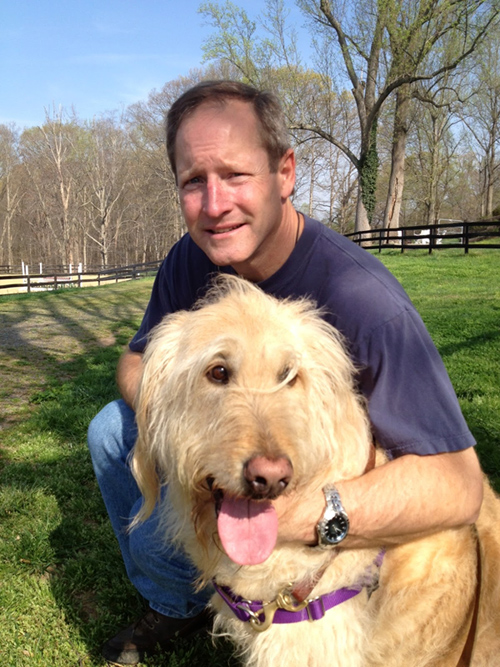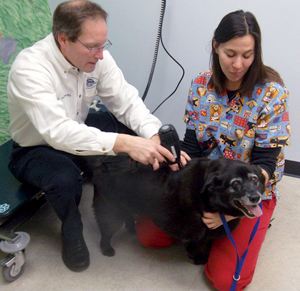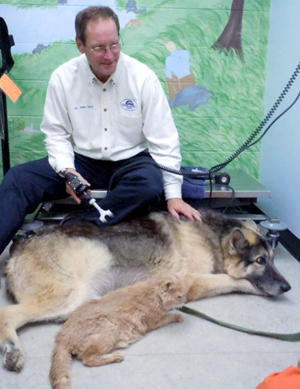John Herrity (DVM '86): Outside the box: Dr. Herrity has success with innovative treatments at Northern Virginia practice
profile by Michael Sutphin
February 1, 2014

Dr. John Herrity (DVM '86) never considered his graduation from the Virginia-Maryland College of Veterinary Medicine to be the end of his education.
Herrity, a practice owner at Burke Animal Cliniclocated 20 miles south of Washington, D.C., has been taking care of pets in Northern Virginia for more than 25 years. In recent years, he had introduced alternative and holistic therapies — such as stem cell treatments and cold laser therapy — into his practice so that his patients have access to the latest advances in veterinary medicine.
“What gets me up at night is trying to figure out how I can help the body heal itself,” said Herrity, who describes his recent efforts with regenerative medicine as a “second career.”
In 2012, Herrity made headlines when he performed stem cell treatments on one of the last remaining 9/11 search and rescue dogs. The patient was “Red,” a 12-year-old black Labrador retriever who was sent to the Pentagon in Arlington, Va., following the 9/11 attacks. Red spent 11 days searching for victims on the Pentagon site and later helped search for survivors after hurricanes Katrina and Rita in 2005.
“This dog gave a lot to us,” Herrity said in a 2012 interview with the Burke Patch about the treatment. “They do searches for remains in burned out buildings. It's the least we can do for these guys.”
By 2011, Red's aches and pains and difficulty performing certain tasks put him into retirement. When his owner brought him to the Burke Animal Clinic, Herrity knew that the dog needed a new approach to treatment. (Bonus: Watch a video of Herrity with Red after the stem cell treatment.)
“When he first came in, Red had trouble moving and was bald or balding,” Herrity said. “After six months of stem cell therapy, his condition was improving and his hair grew back in.”

A pet doesn't have to have search and rescue experience to qualify for outside-the-box treatments, though. The Burke Animal Clinic has expanded to offer a number of alternative therapies for patients in Northern Virginia. According to Herrity, he was the first veterinarian in the area to offer in-house stem cell treatments.
“In the morning, we collect fat and separate out the stem cells to process them,” he said. “Later in the day, we re-sedate the animal to put the cells in the damaged area. We now also have the ability to bank the cells so that they can be used for multiple treatments.”
According to Herrity, alternative therapies such as stem cell treatments often have little to no downside, but a significant upside if successful. “If we have the potential for great gains even if it will not work 100 percent of the time, then why not do it?” he said.
His work is an example of regenerative medicine — that is, the use of the body's own repair mechanisms to treat injuries and other conditions. Regenerative medicine has become a growing area of research at the veterinary college, but when Herrity was a student in the 1980s, the term had not even been coined yet.
Herrity studied animal and poultry sciences and then biochemistry at Virginia Tech before joining the veterinary college's third class. Even though he always intended to enter small animal practice, Herrity fondly remembers his production management medicine rotation, where he learned “cowboy stuff, such as neutering a horse in the field while a storm is approaching and making sure that the procedure is finished in time.”
A two-year-old stallion “cured” Herrity of his fascination with horses, though. His teacher, Dr. Dee Whittier, asked him to hold the lead rope so that the horse did not escape. When the horse became startled, Herrity let go of the rope, much to Whittier's surprise. Whittier is still with the college as a professor of production management medicine in the Department of Large Animal Clinical Sciences.
After graduation, Herrity returned to the veterinary clinic where he had worked since the eighth grade. It's known as the Burke Animal Clinic today and Herrity is one of the owners.
“I've been here since the very beginning,” Herrity recalled about his teenage years working at the clinic. “For the first three months, I worked for free, volunteering to help wherever I could. Then, my boss told me that he had to either fire me or hire me, so he hired me and I stayed through high school. I absolutely love the people and love the practice.”
Herrity and his wife have two sons, Bryan and Patrick, and two daughters, Kelsey and Jessica. A Labradoodle named Bradley and a terrier mix named Rosie complete their family.



